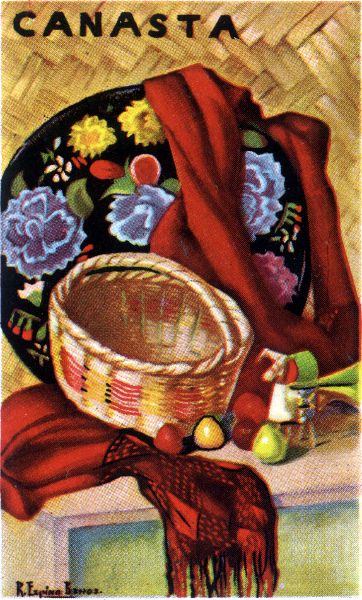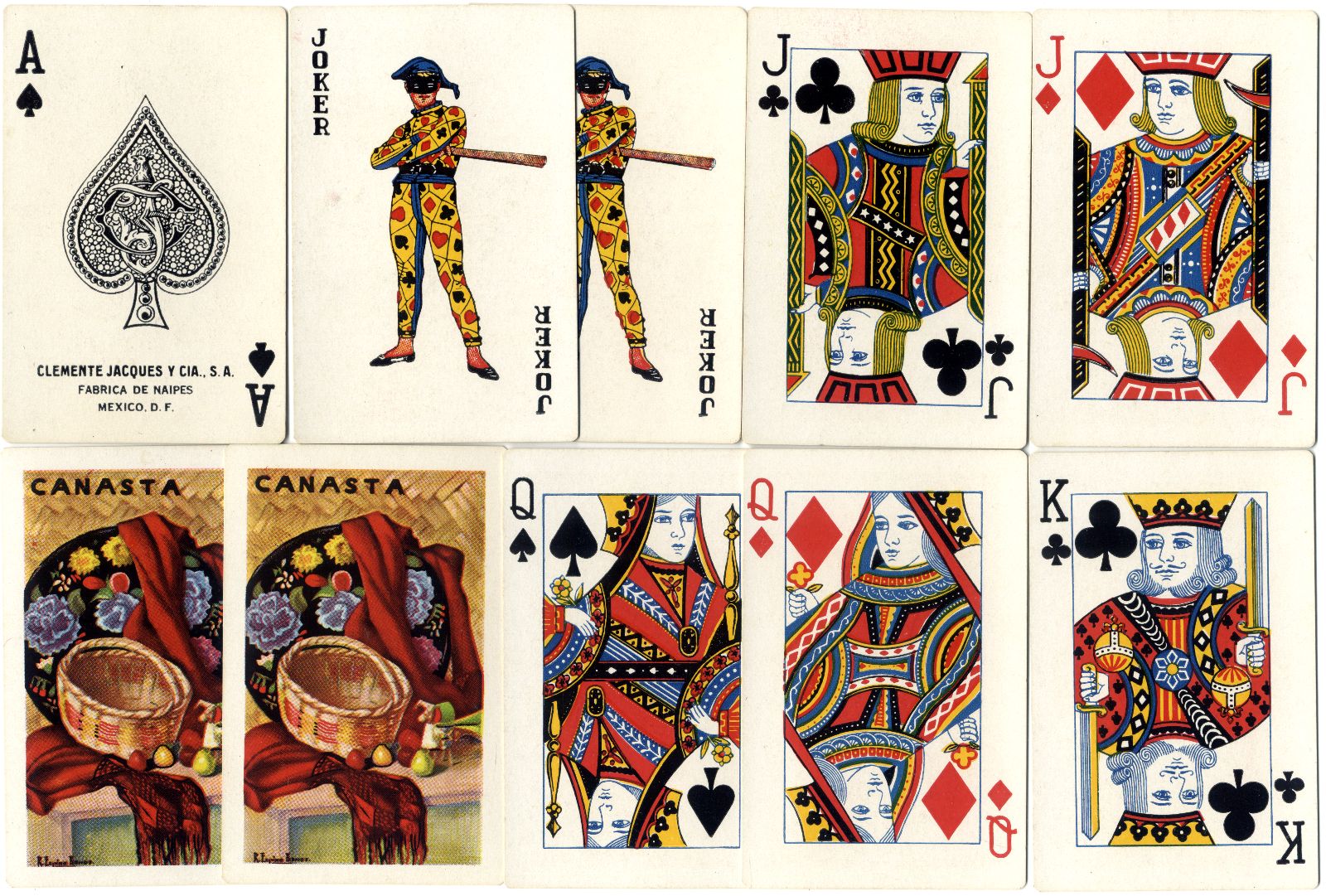Canasta
Mexican Canasta set with paintings by Ramón Espino Barros (1918-2000).

Mexican Canasta set with painting by Ramón Espino Barros
The backs of this double boxed set for Canasta feature a still life painting by the distinguished Mexican artist Ramón Espino Barros (1918-2000). The cards were printed by Clemente Jacques y Cia., S.A., Mexico in c.1950.
As a young boy Espino Barros loved festivities and dreamed of becoming a bullfighter, but he settled for the safer option of painting. He studied with Carlos Ruano Llopis, a Spanish bull-fight artist who had emigrated to Mexico during the Spanish Civil War. He greatly admired Velázquez, Goya and El Greco and defined his own artistic work as ‘realistic impressionism’. During an interview he explained: “pintar, para mí, es una necesidad de tipo biológico ya que si no lo hago, si no pinto, me siento intensamente frustrado, desgraciado e inútil. Así, cuando pinto, por el contrario, siento que existo en armonía conmigo mismo y con el resto de la creación. Si dejo de pintar me asfixio como pez sacado del agua.”
Right: painting by Ramón Espino Barros (1918-2000) on the reverse of a double Canasta set printed by Clemente Jacques y Cia., S.A., Mexico, c.1950 →
Below: the Ace of Spades has the monogram 'CJ' with a small cockerel's head above. Similar cards of the standard Anglo-American type were subsequently published as 'Naipes Cassino' by Pasatiempos Gallo S.A.

Above: double Canasta set with painting by Ramón Espino Barros (born in Jalapa, Veracruz, 1918) on the reverse. Espino Barros is known as a painter of bullfight scenes and Mexican themed paintings. He died in 2000.

By Simon Wintle
Member since February 01, 1996
I am the founder of The World of Playing Cards (est. 1996), a website dedicated to the history, artistry and cultural significance of playing cards and tarot. Over the years I have researched various areas of the subject, acquired and traded collections and contributed as a committee member of the IPCS and graphics editor of The Playing-Card journal. Having lived in Chile, England, Wales, and now Spain, these experiences have shaped my work and passion for playing cards. Amongst my achievements is producing a limited-edition replica of a 17th-century English pack using woodblocks and stencils—a labour of love. Today, the World of Playing Cards is a global collaborative project, with my son Adam serving as the technical driving force behind its development. His innovative efforts have helped shape the site into the thriving hub it is today. You are warmly invited to become a contributor and share your enthusiasm.
Related Articles

Tarot de Valverde de la Vera
A series of 24 surrealist engravings by Mexican artist Claudio Favier in which archetypal Tarot alle...

Visite Mexico
Promoting Mexican tourism with 54 different photographs in full colour.

Tarot Baraja Egipcia
Curious Tarot with Egyptian-style trumps issued by Franco Mora Ruiz from Mexico.

Mexican ethnic playing cards
Mexican ethnic groups depicted on playing cards by Fábrica de Naipes Cuauhtemoc.

Santo Mexico playing cards
Santo Mexico playing cards designed by Cédric Volon with Mexico-associated symbols.

Battles in Mexico, 1847
Uncut proof sheet with Mexican Battle scenes on the aces and portraits of American generals on the c...

Asha Industries’ Castilian pattern
Colourful Spanish (Castilian) pattern cards made by Asha Industries in India for Mexico.

Calaveras De Azúcar
Calaveras De Azúcar playing cards produced by Natalia Silva, USA, 2017.

Baraja Nefertiti
Mexican fortune-telling pack with black and white designs by Thania Nicolopulus.

Mexican Artdeck
Works by 14 different 20th century Mexican artists.

Baraja Maya
Original designs inspired by Mayan art and culture published by Fernando Güemes, Mexico.

Naipe Centenario
Latin American designs by Productora de Naipes y Confetti (Pronaco), S.A., Mexico, c1980.

Spanish pattern by Productos Leo, S.A.
Colourful Mexican version of standard Spanish designs, by Productos Leo, S.A., c.1980s.

Tonalamatl
Baraja Tonalamatl Mexican Aztec playing cards based on the prehispanic Codex Borgia manuscript.

Baraja Taurina Toranzo
Baraja Taurina Mexicana Toranzo with paintings by Antonio Navarrete, 2003

Gallo Intransparente
Gallo Extra Intransparente by Clemente Jacques y Cia S.A., Mexico.
Most Popular
Our top articles from the past 28 days

